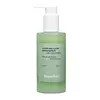What's inside
What's inside
 Key Ingredients
Key Ingredients

 Benefits
Benefits

 Concerns
Concerns

 Ingredients Side-by-side
Ingredients Side-by-side

Ethylhexyl Palmitate
EmollientSorbeth-30 Tetraoleate
EmulsifyingTriethylhexanoin
MaskingCetyl Ethylhexanoate
EmollientIsopropyl Palmitate
EmollientDiisostearyl Malate
EmollientSorbitan Sesquioleate
EmulsifyingCaprylic/Capric Triglyceride
MaskingParfum
MaskingOryza Sativa Bran Oil
EmollientCamellia Japonica Seed Oil
EmollientArtemisia Vulgaris Oil
PerfumingWater
Skin ConditioningMelia Azadirachta Leaf Extract
Skin ConditioningMelia Azadirachta Flower Extract
Skin ConditioningButylene Glycol
HumectantCoccinia Indica Fruit Extract
Skin ConditioningArtemisia Princeps Leaf Extract
Skin ConditioningAmber Powder
Adansonia Digitata Seed Oil
EmollientCamellia Oleifera Seed Oil
Skin ConditioningCarthamus Tinctorius Seed Oil
MaskingCapryloyl Salicylic Acid
ExfoliatingHelianthus Annuus Seed Oil
EmollientHippophae Rhamnoides Oil
EmollientMethylpropanediol
SolventOlea Europaea Fruit Oil
MaskingPersea Gratissima Oil
Skin ConditioningPrunus Armeniaca Kernel Oil
MaskingRibes Nigrum Seed Oil
EmollientSolanum Melongena Fruit Extract
Skin ConditioningCurcuma Longa Root Extract
MaskingOcimum Sanctum Leaf Extract
Skin Conditioning1,2-Hexanediol
Skin ConditioningCorallina Officinalis Extract
Skin ConditioningMoringa Oleifera Seed Oil
EmollientArtemisia Annua Extract
MaskingCentella Asiatica Extract
CleansingEthylhexylglycerin
Skin ConditioningHordeum Vulgare Extract
EmollientEthylhexyl Palmitate, Sorbeth-30 Tetraoleate, Triethylhexanoin, Cetyl Ethylhexanoate, Isopropyl Palmitate, Diisostearyl Malate, Sorbitan Sesquioleate, Caprylic/Capric Triglyceride, Parfum, Oryza Sativa Bran Oil, Camellia Japonica Seed Oil, Artemisia Vulgaris Oil, Water, Melia Azadirachta Leaf Extract, Melia Azadirachta Flower Extract, Butylene Glycol, Coccinia Indica Fruit Extract, Artemisia Princeps Leaf Extract, Amber Powder, Adansonia Digitata Seed Oil, Camellia Oleifera Seed Oil, Carthamus Tinctorius Seed Oil, Capryloyl Salicylic Acid, Helianthus Annuus Seed Oil, Hippophae Rhamnoides Oil, Methylpropanediol, Olea Europaea Fruit Oil, Persea Gratissima Oil, Prunus Armeniaca Kernel Oil, Ribes Nigrum Seed Oil, Solanum Melongena Fruit Extract, Curcuma Longa Root Extract, Ocimum Sanctum Leaf Extract, 1,2-Hexanediol, Corallina Officinalis Extract, Moringa Oleifera Seed Oil, Artemisia Annua Extract, Centella Asiatica Extract, Ethylhexylglycerin, Hordeum Vulgare Extract
Hordeum Vulgare Sprout Extract
AntioxidantWater
Skin ConditioningHordeum Vulgare Extract
EmollientGlycerin
HumectantDisodium Laureth Sulfosuccinate
CleansingLauramidopropyl Betaine
CleansingSodium Lauryl Sulfoacetate
CleansingAcrylates Copolymer
Cocamide Methyl Mea
1,2-Hexanediol
Skin ConditioningTromethamine
BufferingSodium Chloride
MaskingSorbitol
HumectantButylene Glycol
HumectantPotassium Benzoate
PreservativePogostemon Cablin Leaf Oil
MaskingCitric Acid
BufferingDisodium EDTA
Melia Azadirachta Leaf Extract
Skin ConditioningCoco-Glucoside
CleansingDisodium Coco-Glucoside Citrate
EmulsifyingCoptis Japonica Root Extract
Skin ConditioningMelia Azadirachta Flower Extract
Skin ConditioningTheobroma Cacao Seed Extract
AntioxidantRice Ferment Filtrate
Skin ConditioningSaccharomyces/Coix Lacryma-Jobi Ma-Yuen Seed Ferment Filtrate
Skin ConditioningLactobacillus/Phaseolus Radiatus Seed Ferment Filtrate
Skin ConditioningDextrin
AbsorbentCapryloyl Salicylic Acid
ExfoliatingAnastatica Hierochuntica Extract
AstringentBeta-Glucan
Skin ConditioningHordeum Vulgare Sprout Extract, Water, Hordeum Vulgare Extract, Glycerin, Disodium Laureth Sulfosuccinate, Lauramidopropyl Betaine, Sodium Lauryl Sulfoacetate, Acrylates Copolymer, Cocamide Methyl Mea, 1,2-Hexanediol, Tromethamine, Sodium Chloride, Sorbitol, Butylene Glycol, Potassium Benzoate, Pogostemon Cablin Leaf Oil, Citric Acid, Disodium EDTA, Melia Azadirachta Leaf Extract, Coco-Glucoside, Disodium Coco-Glucoside Citrate, Coptis Japonica Root Extract, Melia Azadirachta Flower Extract, Theobroma Cacao Seed Extract, Rice Ferment Filtrate, Saccharomyces/Coix Lacryma-Jobi Ma-Yuen Seed Ferment Filtrate, Lactobacillus/Phaseolus Radiatus Seed Ferment Filtrate, Dextrin, Capryloyl Salicylic Acid, Anastatica Hierochuntica Extract, Beta-Glucan
 Reviews
Reviews

Ingredients Explained
These ingredients are found in both products.
Ingredients higher up in an ingredient list are typically present in a larger amount.
1,2-Hexanediol is a synthetic liquid and another multi-functional powerhouse.
It is a:
- Humectant, drawing moisture into the skin
- Emollient, helping to soften skin
- Solvent, dispersing and stabilizing formulas
- Preservative booster, enhancing the antimicrobial activity of other preservatives
Butylene Glycol (or BG) is used within cosmetic products for a few different reasons:
Overall, Butylene Glycol is a safe and well-rounded ingredient that works well with other ingredients.
Though this ingredient works well with most skin types, some people with sensitive skin may experience a reaction such as allergic rashes, closed comedones, or itchiness.
Learn more about Butylene GlycolCapryloyl Salicylic Acid comes from salicylic acid, the famous acne-fighting BHA.
It usually goes by a more common name of LHA, or lipohydroxy acid.
Like salicylic acid, this ingredient is a chemical exfoliant that can help break down the oil in your pores and reduce inflammation.
Though studies for LHA do show it to be less effective than salicylic acid. To be fair, salicylic acid is the reigning monarch of acne treatments.
However, a study from 2009 found LHA to be comparable to BPO, making it a good alternative for people with sensitive skin. Another study of 14 patients found a significant decrease in comedones after using LHA.
Another pro of LHA? It is less irritating than salicylic acid due to its large molecule size.
Large molecules cannot penetrate skin as well, so they are gentler on the skin. LHA is much less penetrative than salicylic acid.
An in-vitro study (not done on a living organism) found only 6% of LHA penetrated past the statum corneum compared to 58% of salicylic acid. An in-vivo (done on a living organism) analysis revealed ~17% of LHA was still present in the top layer of skin after 4 days, versus ~9% of salicylic acid.
Interestingly, a study from 2008 found LHA comparable to another famous acid, glycolic acid.
This study found about 10% of LHA is as effective as 20-50% of glycolic acid in treating hyperpigmentation and fine-lines.
Hydroxy acids have been found to stimulate skin protein, lipids, and thermal thickening. This may have anti-aging benefits.
Learn more about Capryloyl Salicylic AcidWe don't have a description for Hordeum Vulgare Extract yet.
Melia Azadirachta Flower Extract is from the Neem tree. Neem trees originate from India.
Melia Azadirachta Flower Extract contains antioxidants. Antioxidants help fight free-radicals. Free-radicals are molecules that may damage your skin cells, such as pollution.
The flowers of this tree are lilac colored.
Learn more about Melia Azadirachta Flower ExtractMelia Azadirachta Leaf Extract is extract from the neem plant.
The leaves of this tree contain flavonoids and polyphenols. These two compounds are antioxidants, anti-inflammatory, and antibacterial. Further research is needed as to their effects when applied on skin.
Water. It's the most common cosmetic ingredient of all. You'll usually see it at the top of ingredient lists, meaning that it makes up the largest part of the product.
So why is it so popular? Water most often acts as a solvent - this means that it helps dissolve other ingredients into the formulation.
You'll also recognize water as that liquid we all need to stay alive. If you see this, drink a glass of water. Stay hydrated!
Learn more about Water